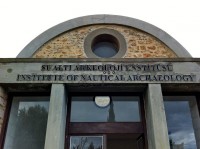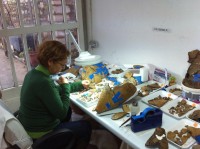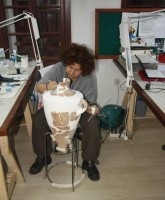10 January 2012
Many of us were unaware of the existence of the Institute of Nautical Archaeology (INA) in Bodrum and visiting this institute was a very interesting and illuminating experience. Our group of 20 people was divided into English speaking and Turkish speaking groups with the help of our group leader Helena Arkun. While John Littleford and Ryan Lee guided the English speaking group throughout their tour of the building, the Turkish speaking group was guided by the Institute director, Tuba Ekmekçi.
10 January 2012
Many of us were unaware of the existence of the Institute of Nautical Archaeology (INA) in Bodrum and visiting this institute was a very interesting and illuminating experience. Our group of 20 people was divided into English speaking and Turkish speaking groups with the help of our group leader Helena Arkun. While John Littleford and Ryan Lee guided the English speaking group throughout their tour of the building, the Turkish speaking group was guided by the Institute director, Tuba Ekmekçi.
The foundation story of INA starts with the first scientific underwater excavation carried out by George Bass and a team of young divers in Cape Gelidonya, Antalya, Turkey. This project led to the birth of the Institute of Nautical Archaeology in 1958 in Texas, USA and to the transformation of the Bodrum Castle into the Museum of Underwater Archaeology. In 1960 the Bodrum Research Centre of INA was established. In this centre with a staff of 20 personnel, researchers and graduate students from Turkey and abroad can do their internship, can join the excavations and work on the subjects of research, restoration and conservation. The objects that have undergone the processes of restoration and conservation are exhibited at the Bodrum museum.
Our visit, which lasted about two hours, started in the library of the Institute which takes up four storeys and contains 7500 books on the subject of archaeology. We then proceeded to the laboratories where the restoration and conservation processes are applied to the wreck salvaged from underwater sites. Lastly, we observed samples of the detailed drawings that are needed at the reconstruction stage at another department of the Institute. Throughout the tour we had the opportunity to meet a dedicated librarian who has also been trained on the restoration of old books who transforms the rare books to a digital environment and who helps researchers access all kinds of archaeological information; archaeologists who clean the dirt of all kinds of materials such as amphorae, wooden pieces or nails and restore them to their original form by use of chemicals and later assemble them with great care; a painter/archaeologist who makes the technical drawings of the objects that have been thus rescued; and two foreign students who were working on their master thesis by trying to cleanse wrecks brought from Yenikapi Istanbul in a damp environment with water tanks. Both the neat, quiet and peaceful atmosphere of the Institute and the enthusiasm of administrators and employees, the sparkle in their eyes and their love and commitment to their work made a great impression on us.
INA’s income is based on endowments. For more information on INA you can visit www.inadiscover.com.
Vivian Kohen



